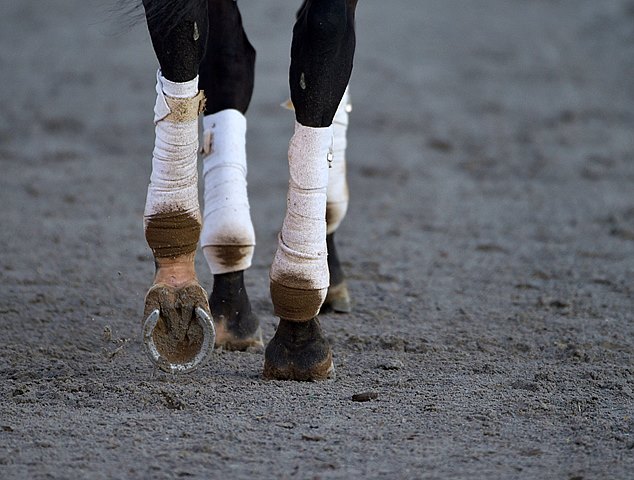A respected equine physiologist who for decades has examined performance data in an effort to improve results for Thoroughbred owners and breeders believes race sensors that track horse movement better than the human eye could provide another tool in the industry's efforts to prevent catastrophic breakdowns.
In an April 8 seminar for the University of Kentucky's Equine Gluck Equine Research Center, Dr. David Lambert, founder of Equine Analysis Systems in Midway, Ky., said the same scientific approaches used to examine equine physiology that have helped breeders produce grade 1 winners and buyers find top-level horses can be applied to prevent catastrophic breakdowns.
Under this approach, the scientific information would be collected by small sensors, about the size of a cell phone and weighing about three ounces, placed in a horse's saddle cloth. Such sensors are already in use and while they initially were used to gauge performance, Lambert sees potential for this data to be used to protect horses at risk to life-threatening injury.
In a compelling presentation outlining the data compiled through a review of thousands of races where such sensors were used in races conducted on the Australian island state of Tasmania over the past decade, Lambert showed how the sensors can pick up jarring motion in a horse—jerk and vibration—that he believes indicate a small injury may have occurred.
In looking at horses who suffered catastrophic breakdowns, Lambert believes that smaller injuries first show themselves to the sensors in the form of this added vibration. He suspects the sensors are picking up the smaller injuries—perhaps the micro fractures that have been linked to catastrophic breakdowns. He sees potential in using the sensors to allow the horse to tell humans when they're hurting.
In Thursday's presentation, Lambert displayed the data from one such horse. The horse consistently traveled with about the same amount of jerk and vibration in his starts until one race where his vibration level was well outside the norm—two standard deviations above the norm. In the start following the effort where the sensors picked up the increased vibration, the horse suffered a catastrophic breakdown.
Lambert believes the sensors from that second-last start flagged a horse who was trying to compensate for injuries that at that point were still relatively minor. This compensation resulted in a less smooth run that the sensors picked up.
"The race immediately before the last, there was a considerable increase in force and there was a considerable increase in instability throughout this race," Lambert noted. In a follow-up conversation, Lambert compared the racing sensors to sensors in today's cars, which measure for small fluctuations in vibration that could indicate something as simple as a tire that needs air. While the driver doesn't notice the increased vibration, the sensor picks up on the change.
Lambert believes that going forward in racing, sensors could be added to detect this added vibration. Horses that show such added vibration could be flagged and taken out of training until the problem is identified—thus preventing catastrophic breakdowns that otherwise may have followed.

"When horses go two, three, or four standard deviations outside their usual pattern, we have to take note of that," Lambert said of the vibration that is documented in race reports produced by the sensors that can be uploaded to a cloud moments after a race. "That horse is giving us a sign. He's screaming out, 'Something hurts. Something is very wrong here and I need help.'"
Tables of the horse Lambert highlighted in Tasmania showed consistent smooth performance from start to start until the problematic increased vibration in the penultimate start. Lambert said the data can differentiate between meaningless changes and a potential danger. For instance, he noted that older horses may see some small increase in vibration throughout their careers but it doesn't reach the level that's seen in horses who have physical issues that could lead to a fatal breakdown. The sensors and data see the differences in those two situations.
Lambert does have a financial interest in the potential for this system as a partner in Stride Safe, which has grown out of sensor developer StrideMaster. Those sensors initially supplied handicapping information to bettors, but Lambert sees added potential in protecting race horses.
While Lambert views the compromised running style as the horse's way of telling humans that it's hurting, he noted that until the development of these sensors, there was no way for humans to receive that message. He said the sensors pick up subtle changes in action that are missed by human evaluation.
In collecting such data, regulatory veterinarians could be alerted when a horse suddenly shows this dramatic increase in vibration. The horse could be taken out of training until the nature of the problem is understood and the horse recuperates. Lambert is optimistic of its potential use in this area because the problematic races come in races before the fatal incidents. Detailed information can readily be made available, and a system can be developed to flag horses of concern.

"The thing is the sensors can pick it up but people can't," Lambert said. "These events are too quick. They're too small for human beings riding and watching them to pick up. Even in bringing them back home and trotting them up and down the blacktop, the horse is going to look sound. It doesn't hurt him to do that. The only way to find the (minor injury that could lead to breakdown) is to get data when it hurts, which is when he's going 40 miles an hour in a race."
Using sensors and this approach on 400 horses at Emerald Downs last year, Lambert said issues were found with some horses who were taken out of training. He believes those actions likely prevented catastrophic breakdowns. That study will continue this year at the Auburn, Wash., track where Lambert said it was well-received by Emerald Downs executive director Phil Ziegler and Washington Horsemen's Benevolent and Protective Association executive director MaryAnn O'Connell.
Catastrophic injury in racing is rare and the industry has committed massive financial resources and effort to further protect horses. Through a multi-faceted approach, this commitment helped lead to a second straight record year for equine safety in 2020 in North America as such incidents were avoided 99.86% of the time and such incidents have been reduced 29.5% since 2009.
Lambert believes use of race performance data could provide an additional tool to further reduce these breakdowns. He noted that just as physiology has helped pick out rare, elite-level horses, it can be an added tool to find these few at-risk horses.
"I believe this is where the racing physiology, racing science, needs to go because it's a whole area we've had nothing to do with, and it's the essence of everything," Lambert said. "How the horse moves, all the things he's doing when he's moving, what his bones are doing—that's what it's all about right? It's about the horse and what this horse is saying to us.
"If we could just get (these sensors) on horses all over the place and have that database all held together somewhere for academics and everybody to investigate; it's mind-blowing what would come out of that. It would be a completely new world for racing and veterinary medicine."









